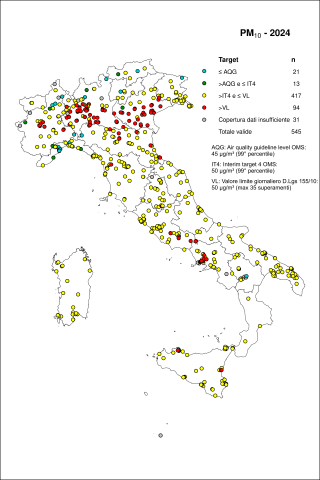Aree
EMISSIONS OF PERSISTENT ORGANIC COMPOUNDS (PAHs, DIOXINS AND FURANS): TREND AND SECTOR DISAGGREGATION
Data aggiornamento scheda:
The indicator represents the trend of national emissions of persistent organic compounds by source sector, from 1990 to 2023. The objective of achieving emission values lower than those of 1990 has been reached both for PAHs (-32%) and for dioxins and furans (-44%), although with different trends.
GREENHOUSE GAS EMISSIONS (CO2, CH4, N2O, HFCS, PFCS, SF6): PER CAPITA AND GDP
Data aggiornamento scheda:
The indicator represents, over the period 1990-2023, the trend of greenhouse gas emissions in Italy per capita and relative to GDP. A decrease is observed for both, accentuated by the growth of the population and GDP, which highlights a decoupling between drivers and pressures.
AMBIENT AIR QUALITY: PARTICULATE MATTER (PM10)
Data aggiornamento scheda:

The indicator is based on atmospheric PM10 concentration data measured in 2023 at monitoring stations distributed across the national territory, collected and archived by ISPRA in the InfoAria database, in accordance with Directive 2008/50/EC (and its national transposition, Legislative Decree 155/2010) and Commission Implementing Decision 2011/850/EU. A total of 573 monitoring stations reported PM10 data. Of these, 541 provided time series with sufficient temporal coverage for validation against reference thresholds. No exceedances of the annual limit value were recorded, whereas the daily limit value was exceeded at 63 stations (equivalent to 12% of cases). Furthermore, the vast majority of monitoring stations reported exceedances of both the WHO annual reference level (91% of cases) and the daily reference level (84% of cases).
GLACIER MASS BALANCE
Data aggiornamento scheda:
The indicator is calculated for a limited sample of Alpine glaciers and represents the algebraic sum of ice mass gained through snowfall accumulation and mass lost through melting during the ablation period. Glacier mass balance data provide a fundamental measure for assessing the "health status" of glaciers.
Analysis of data from 1995 to 2023 shows that, for the glaciers considered collectively, the cumulative mass balance exhibits significant losses, ranging from nearly 25 meters water equivalent for the Basòdino glacier to over 50 meters water equivalent for the Caresèr glacier, corresponding to an average annual mass loss exceeding one meter water equivalent.